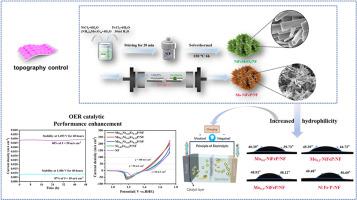Mo-doping directed nanoflower architecture in NiFe phosphide for ultralow-overpotential oxygen evolution catalysis
IF 4.7
3区 材料科学
Q2 MATERIALS SCIENCE, MULTIDISCIPLINARY
引用次数: 0
Abstract
Developing efficient and stable oxygen evolution reaction (OER) electrocatalysts is crucial for advancing industrial-scale hydrogen production. To address the limitations of insufficient active sites and sluggish kinetics in transition metal phosphides (TMPs), we report a three-dimensional hierarchical Mo0.6Ni1.05Fe0.15P/NF nanoflower electrocatalyst fabricated on nickel foam (NF) via stepwise hydrothermal-phosphidation. Synergistic Mo doping critically guides the formation of the nanoflower morphology, yielding a high specific surface area of 59.31 m2 g−1 and abundant edge active sites. This unique architecture, combined with optimized Mo-Fe-Ni electronic interactions that lower the charge transfer resistance to 4.3 Ω, enables exceptional OER performance in 1 M KOH: remarkably low overpotentials of 176, 263, and 351 mV at 10, 50, and 100 mA cm−2, respectively. These values surpass most reported TMP-based catalysts and rival commercial RuO2. Furthermore, the catalyst demonstrates robust stability, maintaining 80 % current density after 48 h of operation. Our work establishes that morphology-composition modulation via high-valent Mo doping effectively enhances active site exposure, optimizes OH− adsorption energetics, and accelerates charge transfer kinetics. This study provides fundamental insights into multi-metallic phosphide design and demonstrates a high-performance, non-precious alternative for practical water electrolysis.

纳米花结构在NiFe磷化物中用于超低过电位析氧催化
开发高效、稳定的析氧反应(OER)电催化剂是推进工业规模制氢的关键。为了解决过渡金属磷化物(TMPs)活性位点不足和动力学迟缓的局限性,我们报道了一种三维分层Mo0.6Ni1.05Fe0.15P/NF纳米花电催化剂,通过逐步水热磷化在泡沫镍(NF)上制备。协同Mo掺杂对纳米花形态的形成具有关键的指导作用,产生59.31 m2 g−1的高比表面积和丰富的边缘活性位点。这种独特的结构,结合优化的Mo-Fe-Ni电子相互作用,将电荷转移电阻降低到4.3 Ω,在1 M KOH下实现了卓越的OER性能:在10、50和100 mA cm - 2下,过电位分别为176、263和351 mV。这些值超过了大多数报道的基于tmp的催化剂和竞争对手的商业RuO2。此外,催化剂表现出强大的稳定性,在48 h后保持80%的电流密度。我们的研究表明,通过高价Mo掺杂的形态组成调制有效地增强了活性位点暴露,优化了OH -吸附能量,并加速了电荷转移动力学。这项研究为多金属磷化物的设计提供了基本的见解,并展示了一种高性能、非贵重的实用水电解替代品。
本文章由计算机程序翻译,如有差异,请以英文原文为准。
求助全文
约1分钟内获得全文
求助全文
来源期刊

Materials Chemistry and Physics
工程技术-材料科学:综合
CiteScore
8.70
自引率
4.30%
发文量
1515
审稿时长
69 days
期刊介绍:
Materials Chemistry and Physics is devoted to short communications, full-length research papers and feature articles on interrelationships among structure, properties, processing and performance of materials. The Editors welcome manuscripts on thin films, surface and interface science, materials degradation and reliability, metallurgy, semiconductors and optoelectronic materials, fine ceramics, magnetics, superconductors, specialty polymers, nano-materials and composite materials.
 求助内容:
求助内容: 应助结果提醒方式:
应助结果提醒方式:


